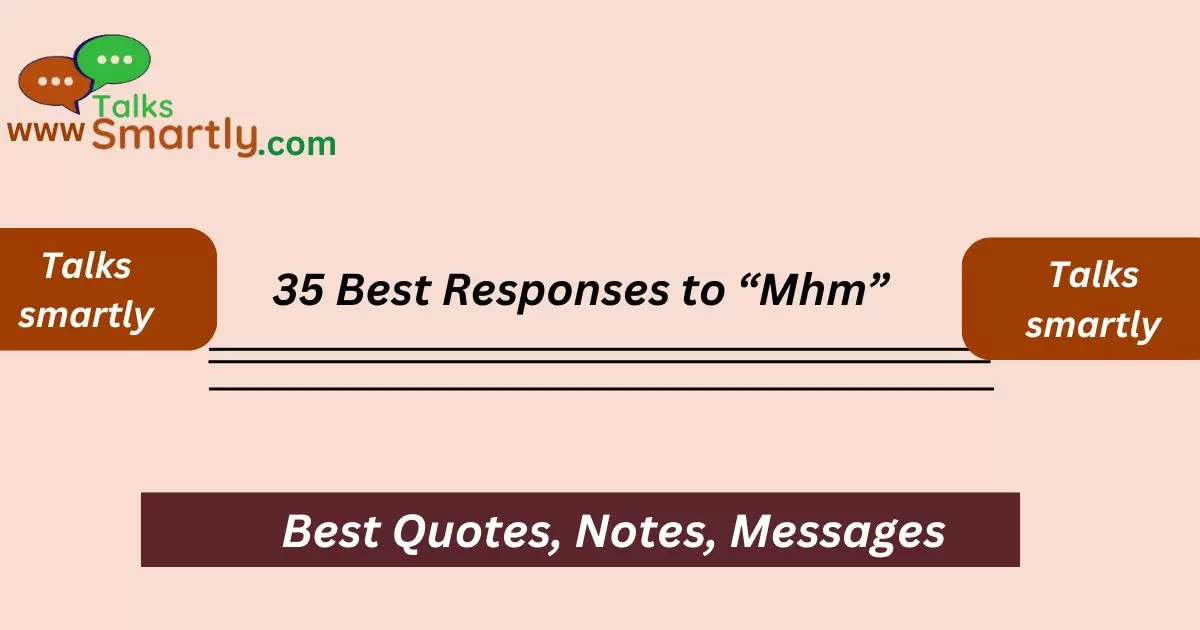“Responding to “mhm” can be tricky, but the right reply keeps the conversation flowing smoothly. Use thoughtful responses to show interest and keep the dialogue engaging.”
“Mhm” is often used in conversation as a non-verbal cue to acknowledge or show agreement. It can sometimes leave you wondering how to respond or move the conversation forward.
In this post, we will explore 35 great responses to “mhm” that can help you keep the conversation lively and engaging. These responses are designed to fit various contexts, whether you’re chatting with friends, colleagues, or acquaintances.
By using these responses, you can keep the conversation going and make sure it stays engaging and interactive.
35 Best Responses to “Mhm”
- I see what you mean
- Got it
- That’s interesting
- Tell me more
- What do you think?
- Could you elaborate?
- I agree
- Absolutely
- Hmm, I didn’t think of that
- That makes sense
- I understand
- Is there more to it?
- Oh, really?
- Can you explain further?
- That’s a good point
- How so?
- Interesting thought
- What are your thoughts on this?
- I hadn’t considered that
- What’s next?
- That’s a valid point
- I see your perspective
- What do you mean by that?
- That’s a new angle
- Care to share more?
- That’s one way to look at it
- I’m curious to hear more
- Could you clarify?
- That’s a thought
- I hadn’t looked at it that way
- Let’s explore that further
- What’s your take on this?
- Is there something specific you’re thinking about?
- Let me get this straight
- That’s an interesting perspective
1. I see what you mean
This response acknowledges understanding and invites more discussion. It shows you are actively engaged in the conversation.
Example: “Mhm, I see what you mean about the project deadline. What’s your plan to address it?”
2. Got it
A brief and straightforward way to show you understand. It’s useful for moving the conversation along efficiently.
Example: “Mhm, got it. I’ll make sure to include that in the report.”
3. That’s interesting
A response that shows curiosity and invites further elaboration. It helps keep the conversation going by expressing interest.
Example: “Mhm, that’s interesting. How did you come up with that idea?”
4. Tell me more
Encourages the speaker to provide additional details. It’s an open invitation for more in-depth conversation.
Example: “Mhm, tell me more about your experience with the new software.”
5. What do you think?
Shifts the focus back to the speaker for their thoughts or opinions. It engages them in deeper discussion.
Example: “Mhm, what do you think about the proposed changes?”
6. Could you elaborate?

Requests additional explanation or details. It’s a polite way to ask for more information.
Example: “Mhm, could you elaborate on how that process works?”
7. I agree
Shows agreement with what was said. It’s a way to affirm that you are on the same page.
Example: “Mhm, I agree. The new approach will definitely improve efficiency.”
8. Absolutely
A strong affirmation that emphasizes agreement. It reinforces your support or understanding.
Example: “Mhm, absolutely. That’s the right strategy for our goals.”
9. Hmm, I didn’t think of that
Expresses that you’ve gained a new perspective. It indicates openness to new ideas.
Example: “Mhm, hmm, I didn’t think of that approach. It could work well.”
10. That makes sense
Acknowledges that the information is logical and clear. It shows you are following the conversation.
Example: “Mhm, that makes sense. The new method aligns with our objectives.”
11. I understand
Confirms that you grasp what’s been said. It reassures the speaker that their point is clear.
Example: “Mhm, I understand your concerns about the budget. Let’s address them.”
12. Is there more to it?
Asks if there are additional details or aspects to consider. It helps uncover more information.
Example: “Mhm, is there more to it? What other factors should we consider?”
13. Oh, really?
Expresses surprise or interest in what’s been said. It invites the speaker to share more.
Example: “Mhm, oh, really? I didn’t know that. Can you explain further?”
14. Can you explain further?
Requests a more detailed explanation. It shows interest and a desire to understand more deeply.
Example: “Mhm, can you explain further how the new policy will impact us?”
15. That’s a good point
Acknowledges the validity of the speaker’s argument or observation. It’s a positive reinforcement.
Example: “Mhm, that’s a good point about the marketing strategy. We should explore it.”
Things to Say When You’re Happy for Someone
16. How so?
Asks for clarification or more details about a statement. It helps you understand the reasoning behind their point.
Example: “Mhm, how so? Can you give me an example of what you mean?”
17. Interesting thought
Shows that you find the idea or perspective intriguing. It encourages further discussion.
Example: “Mhm, interesting thought. How do you think it will affect our results?”
18. What are your thoughts on this?
Invites the speaker to share their opinions or feelings. It encourages deeper engagement.
Example: “Mhm, what are your thoughts on this new proposal?”
19. I hadn’t considered that
Acknowledges that the speaker has provided a new perspective. It shows openness to new ideas.
Example: “Mhm, I hadn’t considered that angle. It could definitely change our approach.”
20. What’s next?
Inquires about the next steps or future plans. It keeps the conversation focused on moving forward.
Example: “Mhm, what’s next for the project? What do we need to do?”
21. That’s a valid point
Affirms that the speaker’s comment is reasonable or correct. It validates their input.
Example: “Mhm, that’s a valid point about the deadline. We might need to adjust our schedule.”
22. I see your perspective
Acknowledges understanding of the speaker’s viewpoint. It shows empathy and consideration.
Example: “Mhm, I see your perspective on the issue. Let’s discuss how we can address it.”
23. What do you mean by that?
Seeks clarification on a specific point. It helps ensure that you fully understand their statement.
Example: “Mhm, what do you mean by that suggestion? Could you elaborate?”
24. That’s a new angle
Recognizes that the speaker has introduced a different perspective. It’s a positive response to new ideas.
Example: “Mhm, that’s a new angle on the problem. It might offer a fresh solution.”
25. Care to share more?
Invites the speaker to provide additional details. It encourages further discussion.
Example: “Mhm, care to share more about how you came to that conclusion?”
26. That’s one way to look at it
Acknowledges that there are different perspectives on the topic. It’s a respectful way to show openness to diverse views.
Example: “Mhm, that’s one way to look at it. Let’s explore other possibilities too.”
27. I’m curious to hear more
Shows genuine interest in learning more about the topic. It invites further elaboration.
Example: “Mhm, I’m curious to hear more about your idea for the project.”
28. Could you clarify?
Requests additional explanation or details. It’s a polite way to seek more information.
Example: “Mhm, could you clarify what you mean by ‘changing the strategy’?”
29. That’s a thought
Acknowledges that the idea presented is worth considering. It shows receptiveness to new ideas.
Example: “Mhm, that’s a thought. Let’s see how we can incorporate it.”
30. I hadn’t looked at it that way
Shows that the speaker’s perspective has offered a new insight. It’s a positive response to a different viewpoint.
Example: “Mhm, I hadn’t looked at it that way. It could offer a new solution.”
31. Let’s explore that further

Encourages deeper discussion on the topic. It shows interest in investigating the idea more thoroughly.
Example: “Mhm, let’s explore that further. It might lead to valuable insights.”
32. What’s your take on this?
Asks for the speaker’s opinion or perspective on the subject. It promotes a deeper conversation.
Example: “Mhm, what’s your take on the new proposal?”
33. Is there something specific you’re thinking about?
Seeks to understand if there is a particular detail or aspect on their mind. It invites further elaboration.
Example: “Mhm, is there something specific you’re thinking about with the new plan?”
34. Let me get this straight
Seeks to confirm understanding of what has been said. It helps ensure clarity.
Example: “Mhm, let me get this straight. We’re moving forward with the new timeline?”
35. That’s an interesting perspective
Acknowledges that the viewpoint shared is unique or thought-provoking. It’s a respectful way to recognize a new angle.
Example: “Mhm, that’s an interesting perspective on the issue. It might open up new possibilities.”
ANSWER TO KEY QUESTION
1. What should I say if someone responds with “mhm”?
Respond with an open-ended question or a statement that encourages further discussion, such as “Tell me more” or “How do you see it?”
2. How can I keep the conversation going after “mhm”?
Use responses that invite additional details or perspectives, like “Can you explain further?” or “What’s your take on this?”
3. What if I don’t understand the context of “mhm”?
Ask for clarification or more information with responses like “Could you elaborate?” or “What do you mean by that?”
4. Are there any responses to avoid after “mhm”?
Avoid responses that may seem dismissive or uninterested, such as “Oh, okay” or “Right.”
5. How can I make sure my response feels genuine?
Ensure your response is thoughtful and relevant to the conversation. Show genuine interest by asking questions or acknowledging their point.
Conclusion
Responding effectively to “mhm” can help maintain an engaging and meaningful conversation. By using these 35 responses, you can keep dialogues active, show genuine interest, and ensure that your interactions are both thoughtful and dynamic. Whether you’re chatting with friends, colleagues, or family, these responses will help you navigate conversations with ease and positivity.












